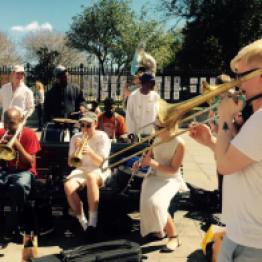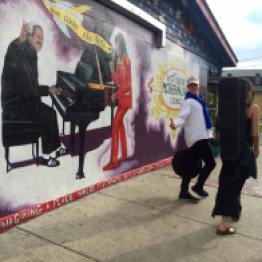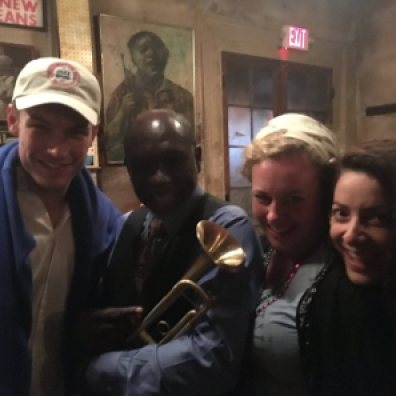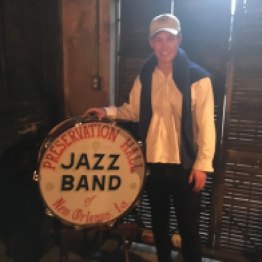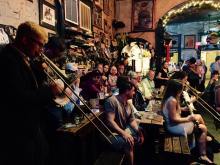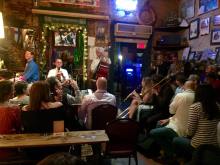The third section of our interview on the 23rd February 2017 with Leroy Jones, Freddie Lonzo, Joe Lastie and Louis Ford at The Preservation Hall, New Orleans
(Missed part 2? Click here to read it.)
Laura: I’m interested to know, in the path of becoming an accomplished jazz musician, what some of the biggest challenges that you’ve faced along the way have been and how you’ve overcome them?
Joe: …Life!
*laughter*
Leroy: I guess times when you don’t have a lot of work, and off the back in the old days, you were on a one or two week notice, so you’d get a week’s notice of two week’s notice, and then there’s another band coming in. But you’ll eventually end up working somewhere else, at least, that’s the way it was on Bourbon Street. You could tell, you’d have a feeling that you were going to get fired not for a reason, just because somebody else – the owner liked them more than you maybe, and wanted to give them a shot.
Louis: Another setback, you know, is that musicians unfortunately have this stereotype, you know, that they do this, they do that, you know…they have a bad rap. ‘No, I don’t want you dating this guy because he’s gonna do this and do that, you know. But that’s not true; all musicians do not do drugs, do not drink, etcetera… for example, dealing with finances, you know. Myself and Leroy, we had a very lucrative job travelling with an icon, perhaps you’ve heard of him, he’s called Harry Connick Jr. – and I walked in the bank one time to sign for a car. [The bank officer said] “Do you have a job?” and I said ‘yeah’, I’m sitting down with the bank officer and he’s ready to sign…”What’s you’re occupation?” ‘Musician’… “Oh…erm, excuse me for one moment.” you know, I was talking to the president of the bank… “I’m sorry, declined.” So then I decided, okay, well I’m going to go back to teaching, you know. Which was a hundred percent less what I was making when I was on the road with Harry – “What’s your occupation?” – teaching!
Louise: At least you could get your car!
Louis: Oh, not a problem! So that could be a setback.
Laura: I’ve had that with car insurance – they wouldn’t insure me because I was a musician, so I told them I was a teacher.
Louise: It’s kind of the same attitude in London towards musicians being debaucherous and not being able to pay.
Laura: Unreliable!
Freddie: Look, if you can’t pay it off in two days, we can’t buy it!
Louis: They say being a musician is inconsistent, but that’s not true! Because we work every day. Actually, me and Joe, we’re in the band, we’re on our fourth cup of coffee right now, because we had four gigs last night! And I have three today, you know, and Joe as well – so we’re constantly working. But you can’t explain that to the bank. They look at you in one way, so that’s a setback.
Joe: And a lot of us need to put our kids through college!
Louis: Exactly, yeah, like he’s just said, my father played with Fats Domino, you know – I’m a fourth generation, and he had five kids, and my father sent those to parochial school – like Leroy mentioned to you, he went to a parochial school, Saint Augustine high school – I went to college, I got a degree in music education. My sisters went to college as well, you know, my brother as well, and all done by my father being a professional musician, you know. He worked seven days – seven days, none stop. Two or three jobs a day.
Joe: That’s true.
Louise: That’s amazing.
Leroy: And back in those days, the gigs that were along here, on this strip, on Bourbon Street, were six times forty-five minute sets.
Louise: Six? Goodness me!
Leroy: Yeah. And some places had three bands a night, and so they’d have eighteen hours continuous music. And you know, you establish yourself. For one thing, musicians, I think…well you have to, for one thing, follow your taxes at the end of the year and have something to show that you’re in the system, legit, even though you’re self-employed. So you can itemise, so you can have deductions on stuff if you’re doing your taxes yourself. Or have a tax accountant do it – I have a tax accountant, because to me it’s very complicated if you’re going to go into that, doing that, the long form is when you getting ten ninety nines where you haven’t gotten…nothing’s been taken out, you’ve got all your money, but you have to pay, you know, you don’t have to, but you should! Not to mention the repercussions if the IRS decides to audit or…you know, same thing everywhere, I’m sure. And I know taxes are really high in the UK, because I’ve played over there and I know how it is for the local musicians, I have friends that I recently toured with over there and I know how it goes there. But here it’s the same, basically. And I think that, you know, it’s almost in America, it’s like your credit is worth more than your collateral. It’s almost like, if you don’t have good credit – you can have as much money as you want – you have a problem; the first thing they’re gonna look at is your credit. Credit check, credit check. I wanna pay cash for the car. Whatever. You know, because it’s all about, you know, they’re trying to make a profit off of you, so…but I think if you’re working a lot and you’re legitimately doing things right, it helps. Not saying you will, but just saying being self employed, performing artist – just to make sure that you keep your papers in order, as far as your taxes and stuff. And I think that can help you to not have to come into a situation where, you know, ‘okay well, we can’t give you this because you’re insufficient on credit or your job is not stable’, you know…whatever.
Louise: Yeah, if you can prove your job’s stable, you should be okay!
Louis: It’s like, you know where you guys are from, again, dealing with demographics, I understand with the music that you’re going to be majoring in – that’s going to be your profession. That area’s going to have to be willing to embrace that profession, you understand what I’m saying? Because, I mean, if I was living in Jamaica and trying to make a living playing traditional jazz, it’s not gonna happen! So, if you wanna focus on being a traditional jazz musician in London, you have to hope that there are going to be clubs there, hotels, that’s gonna embrace that and promote it for you so that you can make a living.
Louise: At the minute, I mean it’s kind of like an underground scene, isn’t it, traditional jazz.
Adam: Yeah, but it is definitely there.
Louise: There’s this kind of hipster revolution where all the kids want to go out swing dancing because, you know, it’s become… they don’t really understand the music or the culture or anything.
Martin: It’s like, films as well, when a new film comes out, like, is it La La Land?
Louise: Yeah like when La La Land came out and everyone was like…I work in a Jazz bar in Greenwich, London, called Oliver’s, which is an amazing place with live bands every night – but Monday to Thursday is pretty much dead; no one comes in. Since La La Land, this film, has come out, it’s been packed every single night! So I suppose…
Martin: It’s a good thing.
Louise: Yeah, I mean, it’s a great thing that that’s happened, but it takes that – it takes some kind of hype to get people involved. And then they’re interested for a couple of months, and then they go onto something else.
Louis: It’s a fad, then it just fades out.
Louise: Yeah, which is frustrating for us, obviously, because this is our life – this is what we care about and this is what we love and are passionate about. So it’s trying to inspire people to get on that boat with us, and I mean, at the minute we’re trying to get people involved and inspired and teach, and you know, I think the most important thing is to access young people and to inspire them, because they are the musicians of the future.
Leroy: Sure.
Louise: And the grown-ups of the future.
Leroy: And the audiences of the future!
Louise: And the audiences of the future, exactly!
Laura: I think it’s also – In England there’s been…unfortunately in Europe it feels like it’s all shifting more towards the conservative side again, which is really sad. And with that, in England now, the arts have been quite slayed, so, when I grew up you had art education, music education in the general curriculum, studying on the state, whereas now they’re removing the arts and all the funding, so…
Leroy: It’s the same thing has happened over here, I mean…and it was the first thing to go. When they’re gonna cut expenses, the arts are out the window. When I was growing up in the early-mid sixties through the seventies, a little boy to teenager, youngsters that didn’t have parents who could afford an instrument for them, instruments were provided at the school – I’ll never forget, York was the brand for brass, we were playing York. Cornets – you had the cornets, trumpets and trombones, you know, and kids could use the instruments throughout the year, school year, and take it home…I think you had to give it back at summer unless you were in a summer camp, but I mean, you had an instrument to take home and practise on. And your folks – many parents couldn’t afford to, you know…a good instrument is expensive, even more expensive today than it was. I mean, I remember my first new horn was a Bundy, a Selmer Bundy, and it was a great horn, a student model – it was $250 in 1969. $250 was a lot of money in 1969 for a new student model horn! Today, when you consider the fact that you get student models now – I’ve seen them now going for $899, $870, you know, so actually, in reference to that, the price has dropped for student model horns. Of course, if you’re talking about professional instruments and custom made horns, you’ve gotta think, you know, it’s like, ‘What’s your bid?’ you know!
Click here for part 4














 Luckily, The Preservation Hall was only a short walk from our hotel, so we had ample time to bide. In the distance we could hear the faint sounds of a brass band, so took a stroll down the street towards it.
Luckily, The Preservation Hall was only a short walk from our hotel, so we had ample time to bide. In the distance we could hear the faint sounds of a brass band, so took a stroll down the street towards it. us was to hold; The sun was shining, the music was swinging and everybody was smiling.
us was to hold; The sun was shining, the music was swinging and everybody was smiling.


